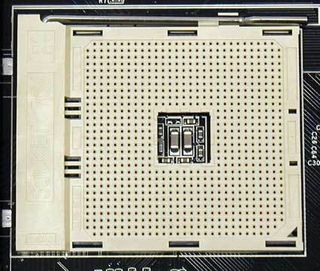New and Improved: NVIDIA nForce3 250 Gb Chipset
Socket 754 Vs. Socket 939

In 2004, socket 754 will dominate AMD's unit sales. But as early as next year, the tide should turn in favor of socket 939.
This year as well, AMD will work with two different processor sockets. One of them is the already well-known socket 754, for which another Athlon64 3700+ with 2.4 GHz speed (Newcastle) is due out by summer, along with, possibly, a faster model by the end of the year. In late summer, the AthlonXP family will also switch from socket A to socket 754. This means that there will be an Athlon64 without 64 bit expansions (codenamed Paris). Versions 2800+, 3000+ and 3200+ are in the works, although the well-known AthlonXPs for socket A will disappear from the product range by 2005 and will serve the low-cost, value processor market.
As far as technology is concerned, AMD will create a respectful distance between the "new" AthlonXP and the Athlon64 by continuing to reduce the L2 cache to 256 kB. This is also necessary for cost reasons, because AMD still only makes its processors using 200 mm wafers based on 130 nm processes, while Intel's Prescott comes from 300 mm wafers and is based on a 90 nm process.
The second socket is socket 939, which in May is slated to replace the well-known socket 940. In the summer, Athlon64 processors based on AMD's 90 nm version will come with a dual-channel DDR controller.
Their nomenclatures will be the code-name Winchester, or Athlon64 3800+, and code-name San Diego, or Athlon64 FX 55. Both will be for socket 939 with a 1 GHz HyperTransport capability and a SSE3 instruction set extension. We can expect the 4200+ by the first quarter 2005.
This year AMD will rely increasingly on socket 754, since product packages based on it can be tied to very attractive pricing and the chip manufacturer can thus expect continuously increasing unit counts: single-channel DDR memory, option to upgrade to a 64 bit chip with AthlonXP purchase, Cool & Quiet for lowering heat loss and cooling, NX bit (non execute) to ward off buffer overflow attacks and other features.
While AMD wants to downgrade socket 754 almost to a pure 32 bit platform, hopes for success in 2005 are based on the Toledo 90 nm chip and socket 939. If the processor were to get a DDR2 memory interface by then, we would once again expect a new processor socket to be launched. Since DDR2-DIMMs have 240 rather than 184 contacts, operation of a DDR2 Athlon64 in socket 939 is not possible with conventional 32 bit DDR2 DIMMs. One possible solution in that case would be 64 bit modules.
Stay on the Cutting Edge
Join the experts who read Tom's Hardware for the inside track on enthusiast PC tech news — and have for over 25 years. We'll send breaking news and in-depth reviews of CPUs, GPUs, AI, maker hardware and more straight to your inbox.
Current page: Socket 754 Vs. Socket 939
Prev Page The nForce3 250 Gb Passes The Athlon64 Performance Jump Hurdle Next Page NVIDIA nForce3 250 Gb In DetailMost Popular

